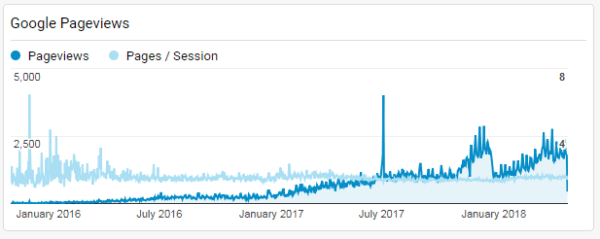Published by Jeremy. Last Updated on July 29, 2020.
Disclaimers: Our site uses demographic data, email opt-ins, display advertising, and affiliate links. Please check out our Terms and Conditions for more information. Listed prices and attraction details may have changed since our visit and initial publication.
There is a lot of talk in the blogging circuit on finding the right niche idea, and there are any number of analyses out there as to why niche building is important.
We thoroughly agree with this point, and rather than rewrite the same article a thousand times over (a huge pet peeve of mine), we want to look at niche building a different way.
You see, everyone looks at niche website building as a way to stand out from the crowd and capture an audience- which is true. But we also look at it from a completely different perspective. We look at it as our ability to create content that is 100% relevant to our niche, such that users (and Google) can quickly understand how all of our posts are connected.
If you pick your niche appropriately, a wealth of traffic is available. Today we’re going to visually show why we think that is while using our travel blogs as an example.
✈️ Book Your Next Trip
- • Planning a trip? Find a flight deal.
- • In need of a room? Check out hotel and apartment prices.
- • Taking a cruise? Find a cruise itinerary for your journey.
- • Don't overlook picking up a rental car or day tours as well!
Your Niche Ideas Have to Fit Into Google
The problem with coming up with a niche idea is that too often your focused site is too broad. Gone are the days where you can simply open a travel blog and succeed, and those who do well have to dive down deeper into one specific topic to be recognized.
When visualizing all of the pages that Google indexes, we would like to think it looks something like this massive bubble below:

Every single one of those trillions upon trillions of sites fits into this bubble, and to be quite honest that is a lot to take in.
For those in the travel market, we are trying to enter into a subset of an otherwise massive sphere- also illustrated graphically above. Is travel really this big in actual websites when compared to Google as a whole? Probably not, but for the sake of argument let’s just assume it is really small compared to all of Google- something we can all agree on.
Now, let’s zoom into the travel market level and try and take a look at how most general travel bloggers fit into that sphere:
As you can see, any given travel blogger is going to cast a rather disjointed web in the travel sphere, and that is a problem. You may have a travel article about Iceland way off to the left, one from Africa to the right, and they may link together through a 3rd general travel topic somewhere in the middle as well. That’s a good start for SEO, but you probably have another 300 that aren’t connected whatsoever and are missing out on a great deal.
Users who search for articles don’t really care that these three articles are related. But Google does, and they look at your site based on an incredible number of factors all while trying to determine if readers will find your site valuable when compared to the billions of other pages out there that fit into this travel-focused bubble.
If you are Google and see this kind of web within a topic, are you going to find it trustworthy? The articles are all over the place and are only loosely connect to each other. From an algorithm/search engine crawler’s standpoint, odds are good it is going to have a hard time making heads or tails about what your site is about, and it is not going to call you an authority despite operating in a general field.
Travel is simply too big and there is too much competition to make any headway on the global level such as this.
Niche Websites Cast a Tighter Net
But let’s look at that tiny circle in there labeled “niche,” because this is where real search engine value comes in to play:
Now, when you compare a niche in the travel market to travel or Google as a whole, we’re talking an incredibly focused field. You may be only targeting 0.0000001% of all of Google, but as long as the total monthly searches are still in the millions, as most are, you have an incredibly large pool to draw from in terms of potential readers.
So what happens when you focus on your niche? There is also the added bonus that all of your posts start relating to each other by default.
In our case with our local Pittsburgh travel blog, Discover the Burgh, this happens because every article we write is around Pittsburgh. Unlike a global travel blog that may link an Iceland post to an Africa post, or a general travel post, our Pittsburgh posts link to other Pittsburgh posts, which link to even more, you guessed it, Pittsburgh posts.
Google’s crawlers notice this, and if it has to pick between displaying a post from a site all about Pittsburgh, or a post on the same exact topic from a site with one article about Pittsburgh and 1,000 from who-knows-what, guess which one it is going to show?
I’m pretty sure you know the answer to this one.
Our Own Data from a Global and a Local Blog

The ultimate goal of any search engine is to provide results back to its users. It can do so by overlaying thousands of loosely woven nets like the general travel example we highlighted above, working under the assumption that all of them together will effectively catch everything. Or they could stack up all of the hyper-focused niches side by side, and sometimes overlapping, to ensure they capture everything with a relevant authority backing it.
This is what we’ve seen between our two blogs. Discover the Burgh reached over 250 monthly views from Google in just over 12 months on 100 posts, while on Living the Dream it took nearly eight years and close to 1,000 articles before we started to receive any growth (which we’ve now supercharged through an SEO overhaul). In two more years, Discover the Burgh had higher traffic than Living the Dream altogether.
I don’t know about you, but if I am going launch a new website, going for a tighter niche where we can get the same traffic on 100 posts versus the same traffic on 1,000 posts* is incredibly important. One of those targets you may be able to reach in a year. The other may take five, six, or even ten years to reach and could mess with your income targets considerably.
Will your love of blogging persist until that growth happens?
Or worse, if you’re a travel blogger, will your travel budget?
Have an existing blog that is in need of an upgrade? Check out the following services we personally use!
- BigScoots - Premium managed hosting with plans as low as $35/month.
- GeneratePress - A customizable theme designed for site speed.
- AdInserter Pro - A widget logic plugin that is quite powerful.
- WP Rocket - An image and caching optimization plug-in.
- Mailerlite - Cost effective newsletter service.
- Keysearch - Keyword research tool for SEO.
- Pretty Links Pro - A great link cloaking tool to clean up affiliate links.
About Jeremy

About the Author: Jeremy is a full-time travel writer based in Pittsburgh and primary author of this site. He has been to 70+ countries on five continents and seeks out new food, adventure activities, and off-the-beaten-path experiences wherever he travels.


